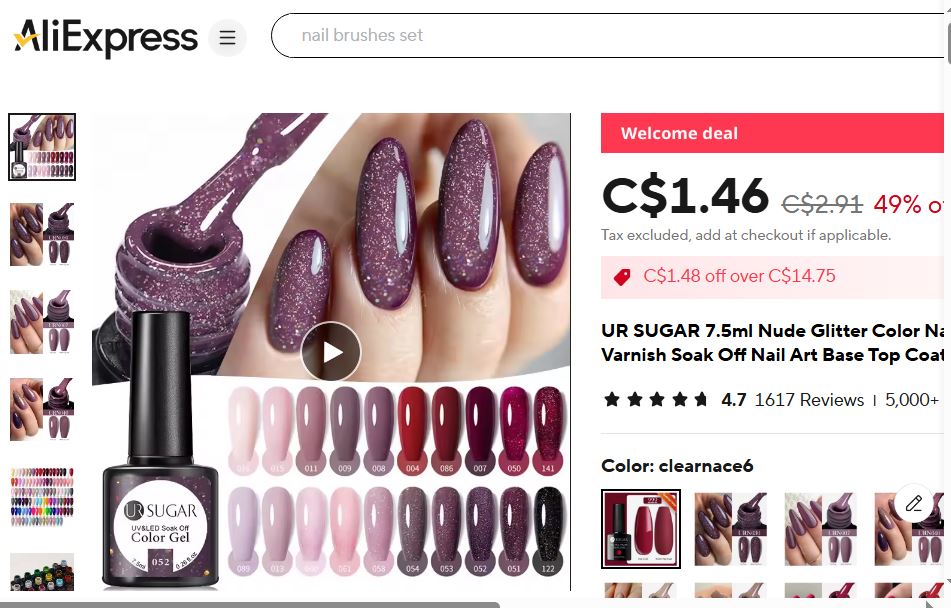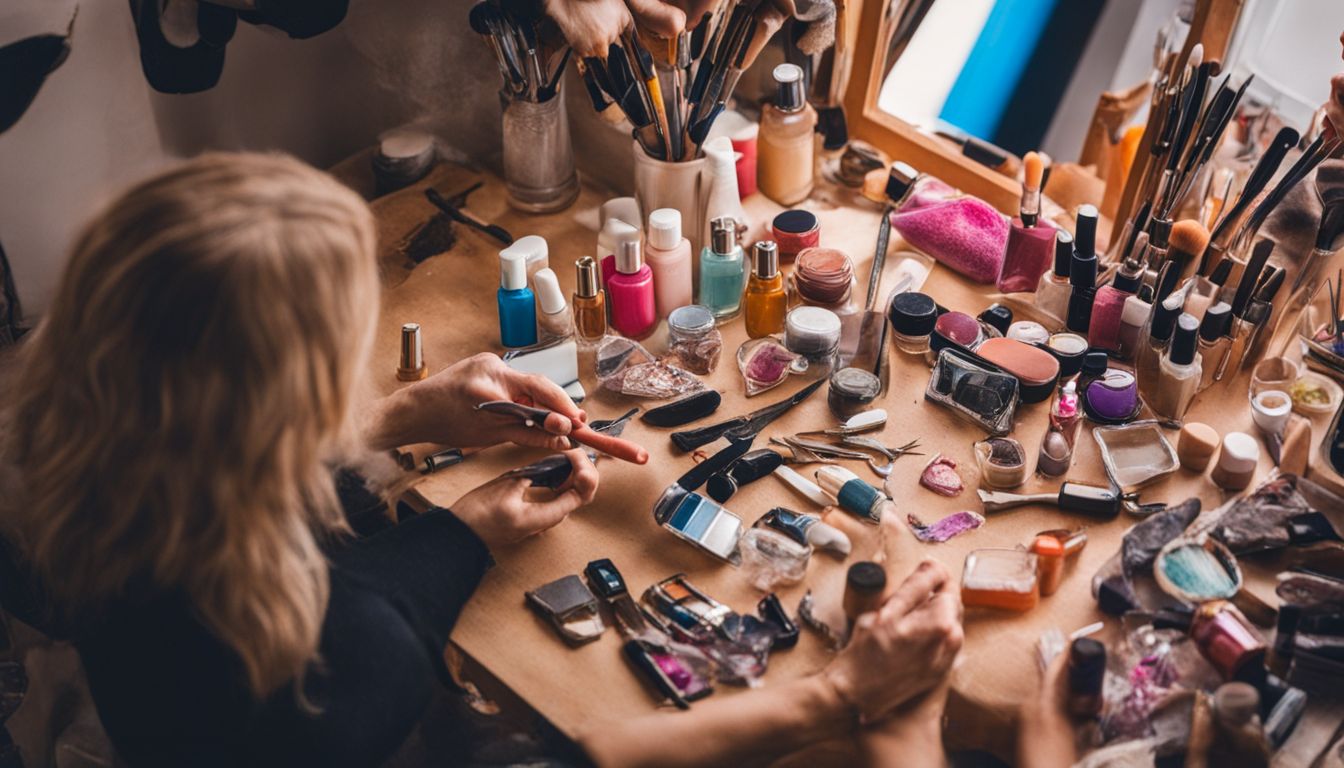We may earn money or products from the companies mentioned in this post.
Ever find yourself staring at chipped nails, wishing for salon-perfect fingers without the hefty price tag? Here’s a fact: you can achieve that polished look right at home. Our guide walks you through every step, from gathering your manicure kit to applying that final top coat, ensuring you get professional results on a budget.
GREAT BARGAIN GREAT DEALS!!









Get ready – your DIY manicure journey starts now!
Key Takeaways
- Get the right tools like nail clippers, files, cuticle pushers and nippers, base and top coats, plus your favorite polish for a great home manicure.
- Trim and shape your nails first then focus on care with cuticle oil and moisturizing before painting to make sure your polish looks its best.
- Use thin layers of polish and let them dry well between coats to avoid smudging. Reapply top coat every 2-3 days to keep nails shiny and chip-free.
- Add fun with techniques like French tips or nail art for a salon look. Gel polish is also an option for longer-lasting wear but needs more care in application and removal.
- Take care of your nails daily by filing gently, moisturizing hands and cuticles, protecting them from water and chemicals with gloves, fixing chips quickly, and redoing when necessary to maintain a fresh look.
Essential Tools for an At-Home Manicure

So, you’re ready to give yourself a fancy nail do-over at home? You’ll need a few key items – like fingernail trimmers and polishers, cuticle pushers and snippers, undercoat and overcoat liquids, plus some colorful varnishes to get started.
Nail clippers
Nail clippers
DIY manicure
clean before you start
nails healthy and looking good
After cutting, check each nail. Make sure they all have the same shape and size. This might seem simple, but it’s key for a home manicure that looks professional. It sets the stage for everything else, from polish to nail art.
Nail file and buffer
You’ll need a good nail file and buffer to shape your nails just right. Think of the nail file as your best buddy for keeping those edges smooth and getting that perfect shape you’re after.
Whether you prefer them square or round, it’s all in the wrist action! Now, onto the buffer—this little tool is key for making sure the surface of your nail is nice and even. No more annoying ridges or uneven spots! By smoothing things out, your polish will go on like a dream and look way shinier.
So grab these essentials before starting the rest of your manicure routine. They’re like the unsung heroes of nail care, setting you up for success from the start. Next up? Taking care of those cuticles with a pusher and nippers.
HOW TO MAKE A FULL TIME INCOME WITH POPULAR ONLINE GAMES THE NEWEST FASTEST GROWING TREND CLICK IMAGES BELOW!!
Cuticle pusher and nippers
Cuticle pusher and nippers are key tools for a top-notch DIY manicure. First, apply cuticle remover to soften them up. Then, use the cuticle pusher to gently move back your cuticles.
It’s like giving your nails a little push to look neat and tidy without any fuss. After pushing them back, grab the nippers but be gentle! You’re just snipping away tiny bits of dead skin that stick out.
Think of it as precise trimming to keep everything clean around your nail beds.
My first time using both was a game changer. I learned quickly that less is more with nippings–a small clip here and there made a huge difference in how polished my nails looked afterward.
Plus, doing this prep made applying polish way easier since I wasn’t fighting against rough edges or overgrown cuticles getting in the way of that smooth finish we all love on our fingernails.
Base coat and top coat
After taking care of your cuticles, it’s time to talk about base coats and top coats. Think of the base coat as a primer for your nails. It’s a must if you want your nail polish to stick around without chipping.
Plus, it stops dark polishes from staining your nails. I learned this the hard way after rocking a deep blue polish without a base coat—my nails were not happy!
Then comes the top coat. This is like a shield for your manicure. Not only does it add shine, but it also makes your color last longer. Reapplying the top coat every 2-3 days keeps things looking fresh and prevents chips.
I’ve found that my DIY manicures can look salon-quality just by being diligent with these steps—I’m confident on this one!
Nail polish
Now that we’ve talked about the base and top coats, let’s move on to the star of the show: nail polish. For a DIY manicure that lasts, picking the right varnish is key. Brands like Olive & June, OPI, and Essie are favorites for their quality and staying power.
These brands offer a spectrum of colors and finishes to match any mood or outfit.
Begin by applying one coat of your chosen color; wait for it to dry completely for about 3-5 minutes before going in with a second layer. This method ensures an even application and helps avoid pesky smudges.
Following these steps will give you beautiful nails and make your at-home manicure look professionally done.
Step-by-Step Guide to the Perfect At-Home Manicure
Want to nail the perfect manicure without stepping out? It’s all about starting with clean, shaped nails and then moving onto polish. You need a few simple tools like clippers and files, and from there, it’s painting time – first with a base coat, then your favorite color, and sealing it off with a top layer for that glossy finish.
Easy steps turn into stunning nails!
Cleaning and prepping nails
Getting your nails ready for a manicure at home starts with cleaning and prepping them right. First, let’s talk about making those nails clean and moisture-rich before starting with the painting part. Here’s how:
- Start by using an acetone-free nail polish remover to get rid of any old nail polish gently. Acetone can be harsh on your nails, so opting for a gentler solution keeps them strong.
- Next, wash your hands with a mild cleanser. This isn’t just about hygiene; it ensures that there’s no oil or dirt left on your nails that could mess up your manicure.
- After washing, it’s time to give those hands some love with moisturizer. Choose one that’s rich but not too greasy. You want your hands soft, but you don’t want the moisturizer affecting the nail polish.
- Now, gently push back your cuticles with a cuticle pusher. It’s important not to cut them since they protect your nails from bacteria.
- Buffing is next on the agenda—the smoother the surface of your nails, the better the polish will stick and stay.
- Before applying any color or base coat, swipe each nail with a little more of that gentle nail polish remover—just to ensure there’s no leftover moisturizer or oil.
- Last but not least, grab an emery board—not too rough—to shape those tips into your preferred style: round, square, or maybe something in between!
There you have it! With these steps, you’ve laid down perfect groundwork for a mani that looks professional—right in the comfort of home.
Shaping nails
Once your nails are clean and prepped, shaping them is the next step to a great DIY manicure. This process gives your nails a neat appearance and sets the stage for polish.
- Pick up your nail clipper. Start by trimming your nails to the desired length. Keep in mind, shorter nails are easier to manage and less likely to break.
- Choose the right shape for your nails. Whether you’re going for a round, square, or oval look, think about what complements your hand and finger shape best.
- Use a nail file to refine the shape. Move the file in one direction along the edge of each nail to prevent splitting. Start on one side, come to the tip, and then go down the other side.
- Smooth edges with small strokes. Don’t saw back and forth with the file – that can cause damage.
- Get a buffer block out now. Gently glide it over the top of your nails to make sure they’re smooth all over.
- After shaping each nail, wash your hands again or swipe them with a bit of nail-polish remover on a cotton ball. This step removes any filing dust and oils that could mess up your polish.
7a. If you notice any rough spots or tiny tears at this stage, be patient and go back in with your file – gently does it!
7b. Finally, take another look at your work from all angles – both sides and top views – so you know each nail is perfectly shaped before moving on to applying base coat.
This careful shaping routine helps create a solid foundation for a salon-quality home manicure result every time!
Applying base coat
Alright, now that you’ve got your nails shaped just how you like them, it’s time to focus on one of the most crucial steps: applying a base coat. This isn’t just a quick swipe of polish — doing it right can make a huge difference.
- Clean Your Nails: Make sure there’s no dust or polish from previous manicures on your nails. Use a mild cleanser and a brush to get into all the nooks.
- Apply Cuticle Oil: Before you start with the base coat, gently apply some cuticle oil. This keeps your nail bed nourished and protects your skin from any nail polish mishaps.
- Choose Your Base Coat Wisely: Not all base coats are created equal. Look for one that suits your nail type – whether that’s brittle, thin, or strong. This product acts as a shield to protect against staining and helps the color stick better.
4.—Yes, shake your base coat bottle before use but don’t go crazy with it. A good 30-second shake mixes the product well without causing air bubbles.
5.—Now for the fun part: Apply a thin layer of base coat to each nail. Start from the cuticle area and drag the brush to the tip of your nails in smooth strokes.
6.—Wait for It… Give your base coat enough time to dry completely before moving on to applying color. Rushing this can lead to smudges or dents.
7.—Cleanup Any Mistakes: Use a small brush dipped in nail polish remover for any errors around the edges or if you’ve painted onto your cuticles by accident.
8.—Consider Applying Two Thin Coats: If you have very ridged or uneven nails, two layers of thin base coat might work better than one thick layer for creating a smooth surface.
9.—Always Cap Off The Edge: Dragging your brush across the tip of each nail seals in the base coat and prevents early chipping.
10.—Let Each Layer Dry Fully: Before adding color on top of your base layer, let it dry fully. Touch it lightly—if it feels even slightly tacky, give it more time.
Following these simple yet effective steps ensures that your DIY manicure not only looks fabulous but also lasts longer without chipping away at those busy hands moments!
Painting nails with chosen color
Painting your nails at home can be as fun and satisfying as going to a salon. You just need your favorite polish and a little patience. Here’s how you can nail the perfect color application, every single time:
- First, grab your base coat. Painting a thin layer on each nail protects them and helps the color stick better.
- Wait for the base coat to dry completely. This might test your patience, but it’s worth it!
- Now, shake your chosen nail color well before opening it. This mixes the pigment evenly so you get true-to-bottle color.
- Start with one stroke of polish down the center of your nail, followed by one on either side. The key is to cover the entire nail in three strokes max.
- Keep each polish layer thin. Thick layers take forever to dry and tend to smudge easily.
- After applying the first coat of nail color, give it 3-5 minutes to dry before adding more layers.
- Go for a second coat if you want deeper color coverage. Make sure it dries completely before moving on.
- Finish with a top coat to seal in the color and add shine—the cherry on top for durability.
- Finally, clean up any mistakes around your nails with a small brush dipped in nail polish remover.
And there you have it! With these tips, you’ll master DIY manicures in no time—saving money and having fun in the process!
Sealing with top coat
A top coat is like a shield for your nail color. It keeps the shine in and the chips out, making your manicure last longer.
- After you paint your nails with your chosen color, wait for it to dry completely. This might take a bit, so be patient.
- Grab your top coat polish. Look for one that says “quick-drying” or “long-lasting” to get the best results.
- Start at the base of your nail and swipe up to the tip. Make sure you cover the whole nail.
- Don’t forget to cap the edge of your nail too! This means painting a tiny bit over the front tip of your nail. It helps prevent chipping.
- Some people love adding a second layer of top coat for extra protection. If that’s you, go for it! Just let the first layer dry first.
- To make your manicure really stand out, some top coats offer extras like a gel look or added sparkle.
- Keep in mind that reapplying top coat every 2-3 days boosts its life span.
- Avoid quick-dry sprays though; they can sometimes make the polish peel off faster.
- If you mess up a bit, don’t worry. Use a small brush dipped in nail polish remover to clean around the edges of your nails.
- Lastly, give your nails plenty of time to dry after applying the top coat—don’t rush this part! Try not to touch anything or do activities that could smudge them.
Following these steps will help keep your nails looking shiny and fresh until it’s time for a new manicure adventure!
Advanced Techniques for Professional Results
Want to make your nails look like they just came from the salon? We’ve got tips on French designs and adding fun drawings that will up your nail game.
Creating a French manicure
To create a French manicure, start by trimming and filing your nails. Make them look neat and even. Use a nail buffer to make the surface smooth. Then, apply a clear base coat; it helps your polish last longer.
Now, for the tricky part – painting the tips white. Don’t go heavy with the white polish! Thin coats work best. Let each coat dry before adding another one. After that, paint all of your nail with a sheer pink or nude color.
This gives you that classic French manicure look.
I tried this at home following these steps and here’s what I found: patience is key! Waiting for each layer to dry can feel like forever, but it’s worth it for a smudge-free finish.
Also, applying thin coats really made a difference – my tips didn’t chip as quickly as they used to with thicker coats of polish. To keep everything looking fresh, I added a top coat every couple of days just like recommended—and guess what? My French manicure lasted way longer than expected!
Applying nail art
After mastering the French manicure, you’re ready to tackle nail art. This is where your DIY manicure turns into real fun. You’ll need a steady hand and a bit of patience, but don’t worry—practice makes perfect.
Start with simple designs using tools like dotting instruments or small brushes from your home nail salon kit. These will help you add dots, lines, or even shapes onto your nails.
For those feeling adventurous, try using stickers or stamps for an easy yet impressive look. Nail art ideas can range from subtle accents to bold patterns—whatever fits your style! Olive & June and OPI offer fantastic options that promise quality and give your creations that professional touch.
Letting each layer dry is key to avoiding smudges. So go ahead, experiment with different colors and techniques to make each nail a tiny masterpiece.
Using gel polish
Gel polish stands out for giving your nails a sleek, shiny look that lasts longer than regular nail polish. You’ll need to paint your nails with it, then use a UV or LED light to set it.
This step makes the polish hard and chip-resistant, making sure your manicure looks fresh for weeks. Think of this as bringing the salon experience into your home; no more chips after two days!
To get rid of gel polish, you can’t just swipe it off with nail polish remover. You need acetone and some patience to soak it off. Yes, using gel means a bit more work both in application and removal steps.
But if you’re aiming for that long-lasting shine and durability, stepping up to gel is worth the effort. Just make sure you have all the right stuff – like a good quality LED lamp and pure acetone – before starting DIY gel nails at home.
Maintaining Your Manicure
Keep your nails looking good with some daily love. Take a moment each day to check them out, use hand lotion to keep your skin soft, and fix any chips in your polish right away.
Daily nail care tips
Taking care of your nails every day keeps them looking great and healthy. It’s not hard to include these steps into your daily routine for better nail health.
- Use a gentle nail file to smooth edges. Avoid harsh metal files that can split nails.
- Moisturize your cuticles with oils like jojoba or almond oil. This prevents them from getting dry and rough.
- Apply a hydrating hand cream daily, especially after washing your hands. Hand washing can strip moisture from your skin and nails.
- Wear gloves when doing dishes or cleaning. Harsh chemicals in cleaners weaken nails.
- Keep nails dry and clean to stop bacteria from growing under them.
Trim nails regularly with sharp nail clippers to maintain a manageable length and prevent breakage.
7.
Drink plenty of water every day. This helps keep the whole body, including your nails, hydrated.
8.
Eat foods rich in biotin like eggs, almonds, and avocados for stronger nails.
9.
Reapply the top coat every 2-3 days without forgetting the clean-up brush for mistakes before the final layer, as suggested for manicure longevity.
10.
Fix chips as soon as they happen to prevent further damage to your nail polish job.
11.
Refrain from using your nails as tools to open things which can cause them to break or chip.
12.
At night, apply a thicker hand cream or emollient around the nail area for deep moisturizing while you sleep.
13.
Gently push back cuticles once a week after a shower when they are soft but do not cut them, using a rubber-tipped cuticle pusher instead of metal ones that can injure the nail bed.
When to touch up or redo your manicure
After giving some daily nail care tips, let’s talk about the right time to touch up or redo your manicure. You know, keeping that DIY manicure looking fresh is quite the task. If you’re like me, doing chores and typing away can chip polish quicker than saying “DIY nail art.” So here’s a trick from my own playbook.
A week or so after painting those nails, you’ll likely see some wear and tear—this is normal! That little gap between your cuticles and color? It’s shouting for a quick fix. Swipe on a thin layer of polish to fill in the gaps or go bold with a completely new color.
Now, deciding when it’s overhaul time—that redo moment—is pretty straightforward. If your polish looks more chipped than chic after 7-10 days (the usual lifespan of an at-home manicure), grab your nail polish remover and start fresh.
Keep in mind that gel nails at home might last longer but also require specific gel polish removers when it’s time for change. My personal threshold? When I spot three or more chips, I take it as a sign from the universe—it’s time for something new.
Plus, changing colors is not just good for upkeep; it’s an instant mood lifter!
Conclusion
So, you’ve got all the tips and tricks to nail that at-home manicure. With your clippers, files, and polishes in hand, you’re ready to go. Keeping up with a little care each day makes sure your nails stay looking fresh.
Need to touch up or redo? No biggie — it’s quick and keeps your nails on point without breaking the bank. Who knew getting salon-like nails could be this easy and fun from the comfort of home! Go ahead, show off those skills and flaunt those beautiful nails!
FAQs
1. How can I master the art of a DIY manicure at home?
Mastering a DIY manicure at home involves understanding nail care products, learning easy manicure steps, and having the right manicure tools like cuticle nippers and nail files. It’s all about practice!
2. What are some quick tips for doing gel nails at home?
For gel nails at home, you’ll need a good quality gel polish from trusted nail polish brands, an LED lamp to cure it properly, and some patience! Don’t forget your cuticle care – moisturizers are key.
3. Can I achieve professional results with my home nail salon?
Absolutely! With the right budget-friendly manicure essentials in your kit and by following a regular manicure routine including proper hand and nail care, you can get professional results without stepping foot in an actual salon.
4. What are some natural ways for strengthening my nails?
Natural nail care includes keeping them clean with gentle cleansers (avoid harsh soaps), eating a balanced diet for healthy nails, avoiding biting or picking them…and yes – hydration is crucial too!
5. How do I maintain my nails between DIY manicures?
Regularly filing your nails to keep them shaped nicely along with applying toners or oils to nourish them will help in maintaining your well-manicured hands between sessions.
6. Any hacks for creating fun nail art ideas myself?
Sure thing! You don’t have to be Picasso here; simple dots using toothpicks on dried base coat can look chic too. For more intricate designs though…well that’s where those social media platforms come handy as inspiration!
GREAT BARGAIN GREAT DEALS!!










